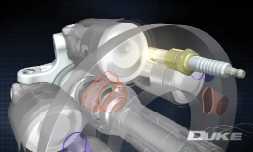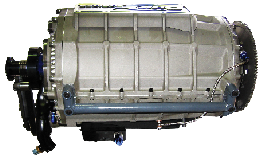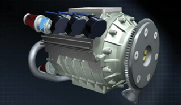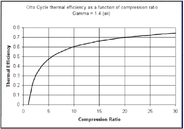A Variable Compression Ratio Duke Engine
The specific nature of a practical variable compression ratio mechanism for the Duke engine has not been finalized.
However, the axial layout lends itself to variable compression ratio with relative ease, and it is likely that a variable compression ratio Duke engine is a real and potentially attractive proposition.
VARIABLE COMPRESSION RATIO
Variable Compression Ratio is being actively researched by many automotive OEM's such as GM, Nissan, Honda, Yamaha, and Mercedes to name a few. VCR is seen as a major potential contributor in improving the fuel efficiency of internal combustion engines. While actively researched, it has not yet entered full production with anyone, the closest to production being the Saab SVC engine of 2002.
A significant reason for not reaching production is the difficulty of achieving Variable Compression Ratio in traditional engine architectures. Ref.1 provides a useful overview of some approaches considered to date.
BASIC THEORY
Spark ignition cycle efficiency is dependent upon the degree of compression and expansion achieved in the operating cycle. In a practical engine the ratios of compression (trapped volume/minimum volume) and expansion (full expanded volume/minimum volume) are similar. In a typically accepted simplification this can be considered a single ratio of the minimum cylinder volume to maximum geometric cylinder volume or, simply the "compression ratio". If further simplifications such as no leakage, no heat transfer between walls and fluid, ideal gas behaviour and zero duration heat replacement are adopted, the Idealized
Otto cycle is then realized:
Otto cycle thermal efficiency (η) = 1 − r(1 − γ)
Where r = compression ratio and γ = Ratio of specific heats for the working fluid (1.4 if approximated to air).

Otto cycle efficiency is not achievable in practice, but as theoretical maximum cycle efficiency it is a useful reference comparator for real world spark ignition cycles.
Generally a high compression ratio results in high cycle efficiency, while a lower compression ratio results in lower structural forces and a higher achievable charge mass before the onset of detonation. Most practical engines have a fixed compression ratio which is selected to give a working compromise between efficiency and performance requirements.
The higher the specific output of the engine, the greater is the compromise between part load and full load optimum compression ratios, and the greater any benefit from being able to vary the compression ratio may be expected to be.
As an example, where an optimum compression ratio might be set at 25:1 at part load Vs a typical value of 10:1 for a fixed compression ratio engine we see a 20% gain in Otto cycle efficiency (Fig 2). While this is a gain in the theoretical maximum efficiency only, it is a useful guide to show the order of thermal efficiency gains possible.
THE DUKE ENGINE & VARIABLE COMPRESSION RATIO
Variable compression ratio in itself is a useful method of enhancing engine efficiency. However the greatest value may be derived from variable compression ratio when seen as an enabling element for other technical approaches.
Downsizing SI engines. There is a current trend towards downsizing or using a small displacement high specific output engine in place of a larger conventional engine. This is typically achieved using aggressive pressure charging to maintain the performance associated with a larger conventional engine. Downsizing places a greater compromise on a fixed compression ratio between full load performance and part load efficiency and as such there is a correspondingly greater benefit from introducing a variable compression ratio. Downsizing with variable compression ratio has been estimated as being capable of providing benefits of up to 35% in drive cycle fuel efficiency (Ref 1). The Saab SVC (pre production) variable compression ratio engine (Ref 2) was a production feasible downsized engine using this concept to achieve a 25% reduction in drive cycle fuel consumption in a "D" category vehicle (Saab 95).
HCCI. Homogenous Charge Compression Ignition (HCCI) HCCI is system of controlled auto ignition of homogenous pre-mixed charge. The combustion of more leaner mixtures is possible with HCCI than with spark ignition. Very lean HCCI operation offers large improvements to part load efficiency and (particularly NOx) emissions (Ref 4). The practicability of operating in HCCI mode is greatly enhanced by the ability to create a fast response variation of the compression ratio.
Fuel quality tolerance. Fuel quality (octane rating) in specified market is one of the key determinants of conventional spark ignition compression ratio selection. High octane fuel availability generally enables higher compression ratio's to be specified, with improved fuel efficiency. Variation of fuel quality across geographic markets requires that the compression ratio of any global vehicle model must be compatible with the lowest fuel quality in the target market areas. This often results in compression ratio (and therefore fuel efficiency) being lower than optimum in some markets. Variable compression ratio would be one method of making global products more optimised across a range of supported markets.

Flex Fuel/Multi-Fuel capability. In an extension to the Fuel octane tolerance effects discussed above, multi fuel operation places even greater variation in optimum compression ratio. The effective octane rating of various fuels ranges from 135 for Methane to <30 for traditional compression ignition fuels (Ref 3). Variable compression ratio would be a key enabling technology in producing a practicable spark ignition engine operating efficiently on a wide range of fuels.

Diesel
Diesel engines are trending towards lower compression ratios currently which allows for high outputs and boost pressures within structural limits. However low compression ratio reduces part load efficiency and the ability to start at low temperatures.
Variable compression ratio would in principle allow a diesel engine to achieve higher full load output with improved part load efficiency while improving cold start capability. Achieving Variable CR on a Diesel engine holds a few more challenges than with spark ignition due to the sensitivity of variation in piston position relative to cylinder head and injector at TDC.
References:
1. Benefits and Challenges of Variable Compression Ratio (VCR): Martyn Roberts, prodrive ltd. SAE paper 2003-01-0398 http://www.prodrive.com/up/vcr.pdf
2. The Variable Compression (SVC) and the Combustion Control (SCC) - Two Ways to Improve Fuel Economy and Still Comply with World-Wide Emission Requirements SAE paper. 2002-01-0996
3. Octane rating of different fuels: http://en.wikipedia.org/wiki/Octane_rating
4. Lotus Omnivore HCCI engine: http://www.lotuscars.com/engineering/en/omnivore-research-engine

